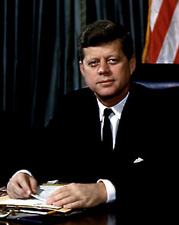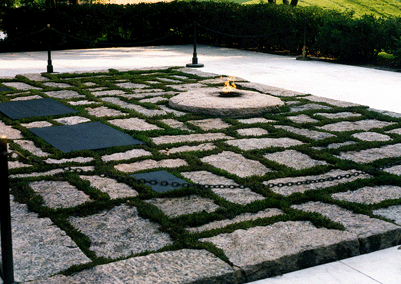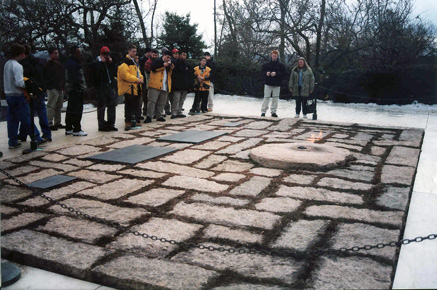 John Fitzgerald Kennedy, often referred to as
J.F.K., was born in Brookline, Massachusetts, the son of Joseph P.
Kennedy, Sr. and Rose Fitzgerald. After attended a couple of elite New
England prep schools, he graduated cum
laude from Harvard University with a degree in international
affairs in June 1940. Interestingly, Kennedy almost was a graduate of
Princeton University instead of Harvard. he enrolled there first, but
was forced to leave because of an illness.
John Fitzgerald Kennedy, often referred to as
J.F.K., was born in Brookline, Massachusetts, the son of Joseph P.
Kennedy, Sr. and Rose Fitzgerald. After attended a couple of elite New
England prep schools, he graduated cum
laude from Harvard University with a degree in international
affairs in June 1940. Interestingly, Kennedy almost was a graduate of
Princeton University instead of Harvard. he enrolled there first, but
was forced to leave because of an illness.
In 1940, Kennedy wrote his honors thesis, entitled "Why England Slept," about the
British dealings concerning the Munich Agreement. His thesis was
published in 1940 and became a bestseller.
He served in the U.S. Navy during World War II (he
voluntered for the Navy in the Spring of 1941 before the attack on
Pearl Harbor after the Army turned him down because of his back
problems) and became a lieutenant, commanding a patrol torpedo (PT)
boat.
On August 2, 1943, Kennedy's boat, the PT-109, was taking
part in a nighttime military raid near New Georgia (near the Solomon
Islands) when it was rammed by the Japanese destroyer Amagiri cutting the boat in two.
Kennedy was thrown across the deck, injuring his already-troubled back.
Still, Kennedy somehow towed a wounded man three miles across open
water to a deserted island (called Plub Pudding Island but has since
been renamed Kennedy island) where his crew was subsequently rescued.
For these actions, Kennedy received the Navy and Marine Corps Medal.
After World War II, Kennedy entered politics, partly to
fill the void of his popular brother, Joseph P. Kennedy, Jr., on whom
his family had pinned many of their hopes but who was killed in the war
during a bombing misson. In 1946, he was elected to the U.S. House of
Representatives from a heavy Democratic district and served three
terms. In 1952, he defeated incumbent Republican Henry Cabot Lodge for
the U.S. Senate. Kennedy married Jacqueline Lee Bouvier on September
12, 1953. During this period, he published Profiles in Courage, highlighting
eight instances in which U.S. Senators risked their careers by standing
by their personal beliefs. The book was awarded the 1957 Pulitzer Prize
for Biography.

In 1960, Kennedy declared his intent to run for President
of the United States. In the Democratic primary election, he faced
challenges from Senator Hubert H. Humphrey of Minnesota, Senator Lyndon
B. Johnson of Texas and Adlai Stevenson, the Democratic nominee in 1952
and 1956, who was not officially running but was a favorite "write-in"
candidate. On July 13, 1960, at the Democratic National Convention in
Chicago, Kennedy was nominated for President. Kennedy asked Johnson to
be his Vice-Presidential candidate, despite clashes between the two
during the primary elections. He needed Johnson's strength in the South
to win what was considered likely to be the closest election since
1916. During the campaign, Kennedy had to overcome the fact he was a
Catholic. In September and October, Kennedy debated Republican
candidate Vice President Richard Nixon in the first televised U.S.
presidential debates. In the election on November 8, 1960, Kennedy beat
Nixon in a very close race.
Kennedy was sworn in as the 35th President on January 20,
1961. In his inaugural address he spoke of the need for all Americans
to be active citizens. "Ask not what
your country can do for you, ask what you can do for your country",
he said.
On April 17, 1961, Kennedy gave orders allowing a previously planned invasion of Cuba to proceed. With support from the Central Intelligence Agency (CIA), in what is known as the Bay of Pigs Invasion, 1,500 U.S.-trained Cuban exiles, called "Brigade 2506", returned to the island in the hope of deposing Fidel Castro. Due to mistakes and miscalculations by the CIA, the invasion turned into a disaster. The incident was a major embarrassment for Kennedy, but he took full personal responsibility for the debacle.
The Cuban Missile Crisis began on October 14, 1962, when
American U-2 spy planes took photographs of a Soviet intermediate-range
ballistic missile site under construction in Cuba. Over the objections
of many military officials who wanted an air assault on Cuba, Kennedy
ordered a naval blockade in which the U.S. Navy blocked Soviet ships
with missles from going to Cuba. He began negotiations with the Soviets
and, a week later, he and Soviet Premier Nikita Khrushchev reached an
agreement. Following this incident, which brought the world closer to
nuclear war than at any point before or since, Kennedy was more
cautious in confronting the Soviet Union.
Determined to stand firm against the spread of communism,
Kennedy continued the previous administration's policy of political,
economic, and military support for the unstable South Vietnamese
government, which included sending military advisors and U.S. Special
Forces to the area.
On June 26, 1963, Kennedy visited West Berlin and gave a
public speech criticizing communism. The speech is considered one of
Kennedy's best, and a notable moment of the Cold War. It was a great
morale boost for West Berliners, who lived in an enclave deep inside
East Germany and feared a possible East German occupation. Kennedy used
the construction of the Berlin Wall as an example of the failures of
communism: "Freedom has many
difficulties and democracy is not perfect, but we have never had to put
a wall up to keep our people in." He went on to say, "All free men, wherever they may live, are
citizens of Berlin, and, therefore, as a free man, I take pride in the
words 'Ich bin ein Berliner!" The Germans loved the speech and
even erected a plaque on the spot where it was given.
Kennedy was eager for the United States to lead the way in
the space race by supporting the Apollo Program. He gave a speech
saying, "We choose to go to the moon
in this decade and do the other things, not because they are easy, but
because they are hard." On July 20, 1969, almost six years after
Kennedy's death, the Project Apollo´s goal was realized when Neil
Armstrong and Buzz Aldrin became the first men to land on the moon.
 Kennedy called
his domestic program the "New Frontier." It ambitiously promised
federal funding for education, medical care for the elderly, and
government intervention to halt the recession. Kennedy also promised an
end to racial discrimination. He sent troops to help a Black man, James
Meridith, enroll at the University of Mississippi (Ole Miss). Kennedy
intervened when Alabama Governor George Wallace blocked the doorway to
the University of Alabama to stop two black students from enrolling.
Later, Kennedy proposed what would become the Civil Rights Act of 1964.
Kennedy called
his domestic program the "New Frontier." It ambitiously promised
federal funding for education, medical care for the elderly, and
government intervention to halt the recession. Kennedy also promised an
end to racial discrimination. He sent troops to help a Black man, James
Meridith, enroll at the University of Mississippi (Ole Miss). Kennedy
intervened when Alabama Governor George Wallace blocked the doorway to
the University of Alabama to stop two black students from enrolling.
Later, Kennedy proposed what would become the Civil Rights Act of 1964.
[PHOTO: The Hudson Catholic JV hockey team
made a trip to Washington D.C. in 2002 and visited Kennedy's gravesite
in Arlington National Cemetery]
Kennedy and his wife "Jackie" were very young in
comparison to earlier Presidents and first ladies, and were both
extraordinarily popular in ways more common to pop singers and movie
stars than politicians, influencing fashion trends and becoming the
subjects of numerous photo spreads in popular magazines. The Kennedys
brought new life and vigor to the atmosphere of the White House. They
believed that the White House should be a place to celebrate American
history, culture, and achievement, and they invited artists, writers,
scientists, poets, musicians, actors, Nobel Prize winners and athletes
to visit.Jacqueline Kennedy also bought new art and furniture and
eventually restored all the rooms in the White House. The White House
also seemed like a more fun, youthful place, because of the Kennedys'
two young children, Caroline and John Jr. The charisma of Kennedy and
his family led to the figurative designation of "Camelot" for his
administration.
Personally Kennedy was never a very healthy person
and lived in almost constant pain, a fact kept from the general public.
He had been diagnosed as a young man with Addison's Disease. In 1937,
Kennedy was prescribed steroids to control his colitis, which only
increased his medical problems causing him to develop osteoporosis of
the lower lumbar spine.
On November 22, 1963, Kennedy and his wife Jackie
traveled on a political trip to Dallas, Texas. While travelling in an
open limosine in a motorcade through Dealey Plaza, Kennedy was shot and
fatally wounded in the back and side of the head. A gunman, Lee Harvey
Oswald, was arrested and charged with the assassination (Oswald was
fatally shot less than two days later in a Dallas police station).
Kennedy was rushed to Parkland Memorial Hospital where he was declared
dead. His body was returned to Washington D.C. aboard Air Force One.
Vice President Lyndon B. Johnson (who had been riding two cars behind
Kennedy in the motorcade through Dallas and was not injured) took the
oath of office on board Air Force One just before it departed Love
Field in Dalles.
Kennedy was placed in the East Room of the White House for 24 hours. On
the Sunday after the assassination, 300,000 people watched a
horse-drawn caisson, which had borne the body of Franklin D. Roosevelt
and the Unknown Soldier, carry Kennedy's flag-covered mahogany casket
down Pennsylvania Avenue to the Capitol rotunda to lie in state. Over
the span of 18 hours, 250,000 people, some waiting for as long as 10
hours in a line that stretched 40 blocks up to 10 persons wide,
personally paid their respects as Kennedy's body lay in state. In all,
220 foreign dignitaries, including 19 heads of state and government,
and members of royal families, from 92 countries, including the Soviet
Union, attended the funeral on Monday, November 25. Archbishop of
Boston, Richard Cardinal Cushing, celebrated the Requiem Mass at
Cathedral of St. Matthew the Apostle in Washington D.C. The casket was
borne again by caisson on the final leg as the late president was laid
to rest at Arlington National Cemetery in Virginia.
Television became the primary source by which people were kept informed
of events surrounding John F. Kennedy's assassination. U.S. networks
switched to 24-hour news coverage for the first time ever. Kennedy’s
state funeral procession was broadcast live in America and in other
places around the world.
Here are some webpages of interest:
White House Biography of John F. Kennedy
The Internet Public Library Biography
The American President Biography
|
|
|
Next: Lyndon B. Johnson |
|
|